http://www.rhci-online.net/radiogram/radiogram.htm
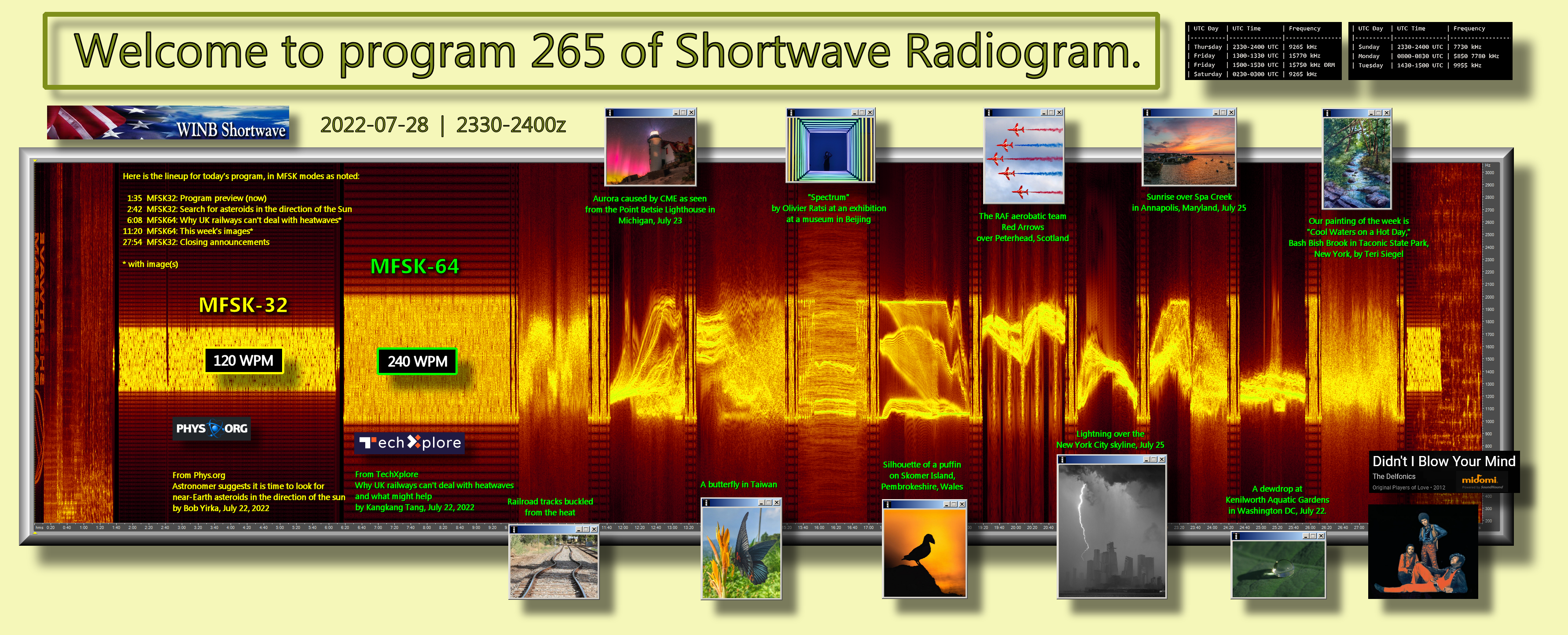
http://www.rhci-online.net/radiogram/radiogram.htm

RSID: <<2022-07-28T23:31Z MFSK-32 @ 9265000+1500>>
Welcome to program 265 of Shortwave Radiogram.
I'm Kim Andrew Elliott in Arlington, Virginia USA.
Here is the lineup for today's program, in MFSK modes as noted:
1:35 MFSK32: Program preview (now)
2:42 MFSK32: Search for asteroids in the direction of the Sun
6:08 MFSK64: Why UK railways can't deal with heatwaves*
11:20 MFSK64: This week's images*
27:54 MFSK32: Closing announcements
* with image(s)
Please send reception reports to radiogram@verizon.net
And visit http://swradiogram.net
We're on Twitter now: @SWRadiogram
From Phys.org
Astronomer suggests it is time to look for near-Earth asteroids
in the direction of the sun
by Bob Yirka
July 22, 2022
Scott Sheppard, an astronomer with the Institute of Astronomy at
the University of Hawaii, has published a Perspective piece in
the journal Science suggesting that it is time for the space
science community to take a closer look at near-Earth objects
(NEOs) that lie in the direction of the sun. In his paper, he
notes that the technology now exists to look for and find such
NEOs, at least during the twilight hours.
As Sheppard notes, most space gazing is fixed at the dark night
sky, when the sky is not overwhelmed with light from the sun. But
as a result, space scientists have ignored the NEOs that orbit
between Earth and the sun. And that could lead to trouble, since
one or more of them could be on a path that leads to them
crashing into Earth.
Scientists are not completely ignoring NEOs that exist in the
sun's glare, of course. Sheppard notes that many of them have
been discovered recently. But he says that more such studies are
required to learn more about them. He points out that one team
recently discovered an asteroid with an orbit inside of Venus's
orbit and another that has the shortest trip around the sun. He
also notes that new facilities have the capabilities needed to
study such NEOs, such as the Zwicky Transient Facility in the
U.S. and the NSF Blanco-4-meter facility in Chile. The latter
even has a Dark Energy Camera that can be pointed closer to the
sun.
NEOs that orbit the sun inside of Earth's orbit have been
categorized based on their orbital positioning—if they travel
inside of Venus's orbit, for example, they are called Vatiras.
Additionally, Sheppard notes that their numbers remain relatively
constant, which is somewhat of a surprise. Based on computer
models and the number of such objects that strike the Earth, the
moon, or other celestial bodies, their numbers should be
dropping. That they are not suggests that they are being
replenished somehow. He thinks efforts should be made to find out
where those other NEOs are coming from, and why.
https://phys.org/news/2022-07-astronomer-near-earth-asteroids-sun.html
Shortwave Radiogram now changes to MFSK64 ...
RSID: <<2022-07-28T23:36Z
MFSK-64 @
9265000+1500>>
This is Shortwave Radiogram in MFSK64
Please send your reception report to
radiogram@verizon.net
From TechXplore
Why UK railways can't deal with heatwaves—and what might help
by Kangkang Tang, The Conversation
July 22, 2022
The UK's rail service has been hit with widespread train delays
and high levels of cancelations during the heatwave. The whole of
the east coast line between Edinburgh and London was closed for
hours on July 20 because of the heat.
So why is the heatwave causing so much havoc on the train lines?
Like most construction materials, steel, which rails are made
from, expands when air temperature increases. When this movement
is restrained by the anchorage, which holds the rail and the
sleeper (the rectangular supports for the rails) in place,
internal stresses build up, and compression buckles or kinks the
rail.
This buckling can cause a long piece of steel, such as a steel
rail, to bend slightly or kink. Trains cannot travel over rail
lines with kinks. In the US, kinks caused by the sun caused over
2,100 train derailments in the past 40 years, equivalent to
around 50 derailments per year.
When air temperature reaches 30°C, rails in the sun can reach
50°C. In the UK a temporary speed restriction is imposed when
rails reach this temperature because trains apply less pressure
on the rails when they slow down. Some railway maintenance teams
paint rails white to cool them down in summer. According to
Network Rail, this can reduce the rail temperature by 5°C, to
10°C. Network Rail workers started painting the train lines
several days ahead of the July heatwave.
Modern rail systems are getting better at holding rails in place.
Most tracks are made up of long pieces of rail that are stretched
and welded together, which helps hold them in place. This reduces
the chance of buckling. When a track is made up of short rails
bolted together, Network Rail leaves small gaps between each one
to allow for expansion in hot weather.
Electric trains are often powered by overhead wires which can
also be damaged by hot weather. Heat can make wires expand and
sag. Too much sag will break the overhead line equipment. A
pulley system keeps overhead wires tense and can compensate for
sag.
How other nations cope
As temperatures rise to unprecedented levels, even Spanish train
lines, which typically cope well in the heat, are buckling and
services are being canceled.
Continuous weld rails, which are used as standard worldwide
including in the UK, are optimized to work around a given
"stress-free temperature" (SFT). The higher this temperature, the
hotter the rails can get without buckling.
In the UK, the SFT is 27°C, the traditional mean summer rail
temperature. In the US, standard values vary between 35°C and
43°C.
If the UK SFT was higher, then the railways could operate in
hotter weather because the rails wouldn't expand so much at
higher temperatures. But if the rails are made for too high an
SFT then they won't be able to cope with the colder temperatures
they experience in winter. This would create tremendous stresses
and the rails could shear off their anchorage.
Some countries' railways are able to cope with such high
temperature variation by using solid concrete slabs to contain
the higher forces created. But slab tracks costs approximately
four times as much to install as standard ballasted track.
Climate change means many countries' railways will more often
reach temperatures they were not designed to cope with,
threatening public transport on a scale never seen before. We
just saw the highest temperature ever recorded in the UK at
40.3°C, well above the previous daily high of 38.7°C in 2019.
During the construction of HS2, the new highspeed railway being
built between London, Manchester and Leeds, bridges and overhead
wires have been fitted with sensors to collect data about weather
including the air temperature. This data will be used to create
the digital twins of HS2, allowing for a new type of maintenance
that can predict high temperatures and other types of disruptive
weather.
A digital twin is a digital representation of the railway
network. This would allow engineers to simulate future scenarios
for the UK rail network and predict what might happen if high
temperatures are forecast, and be able to take preventative
action in advance. This could be one way to prevent some of the
huge cancelations seen in the recent UK heatwave.
https://techxplore.com/news/2022-07-uk-railways-heatwavesand.html
Image: Railroad tracks buckled from the heat ...
Sending Pic:198x143C;
This is Shortwave Radiogram in MFSK64
Please send your reception report to
radiogram@verizon.net
This week's images ...
Aurora caused by CME as seen from the Point Betsie Lighthouse in
Michigan, July 23.
https://bit.ly/3J8fTPX ...
Sending Pic:201x152C;
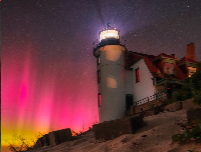
A butterfly in Taiwan.
https://bit.ly/3cGZK8j ...
Sending Pic:176x205C;

"Spectrum" by Olivier Ratsi at an exhibition at a museum in
Beijing.
https://bit.ly/3cH2ouq ...
Sending Pic:195x144C;

Silhouette of a puffin on Skomer Island, Pembrokeshire, Wales.
https://bbc.in/3BfAnVh ...
Sending Pic:185x198C;
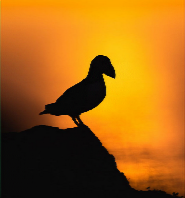
The RAF aerobatic team Red Arrows over Peterhead, Scotland.
https://bbc.in/3zxKKSU ...
Sending Pic:176x192C;
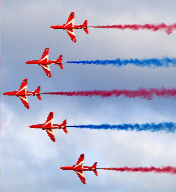
Lightning over the New York City skyline, July 25.
https://bit.ly/3S2xxZt ...
Sending Pic:242x301;
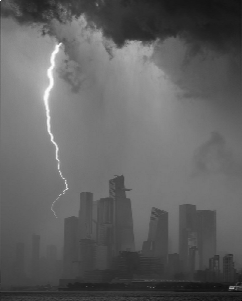
Sunrise over Spa Creek in Annapolis, Maryland, July 25.
https://bit.ly/3b6Ubzr ...
Sending Pic:207x152C;

A dewdrop at Kenilworth Aquatic Gardens in Washington DC, July
22. https://bit.ly/3zz3666 ...
Sending Pic:209x127C;

Our painting of the week is "Cool Waters on a Hot Day," Bash Bish
Brook in Taconic State Park, New York, by Teri Siegel.
https://bit.ly/3RUSNQW and
https://bit.ly/3z19dys ...
Sending Pic:151x204C;
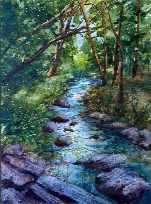
Shortwave Radiogram returns to MFSK32 ...
RSID: <<2022-07-28T23:58Z
MFSK-32 @
9265000+1500>>
This is Shortwave Radiogram in MFSK32 ...
Shortwave Radiogram is transmitted
by:
WRMI, Radio Miami International, wrmi.net
and
WINB Shortwave, winb.com
Please send reception reports to
radiogram@verizon.net
And visit http://swradiogram.net
Twitter:
@SWRadiogram or twitter.com/swradiogram
I'm Kim Elliott. Please join us for the next Shortwave
Radiogram.
http://www.rhci-online.net/radiogram/radiogram.htm
|
QTH: |
D-06193 Petersberg (Germany/Germania) |
|
|
Ant.: |
Dipol for 40m-Band & Boomerang Antenna 11m-Band |
|
|
RX for RF: |
FRG-100B + IF-mixer & ICOM IC-R75 + IF-mixer |
|
|
Software IF: |
con STUDIO1 - Software italiano per SDR [S-AM-USB/LSB] + beta 11 Version 2.80 (August 21, 2018) - for scheduled IF-recording |
|
|
Software AF: |
Fldigi-4.0.18 + flmsg-4.0.7 images-fldigifiles on homedrive.lnk |
|
|
OS: |
German XP-SP3 with support for asian languages |
German W7 32bit + 64bit |
|
PC: |
MEDION Titanium 8008 (since 2003) [ P4 - 2,6 GHz] |
MSI-CR70-2MP345W7 (since2014) [i5 -P3560 ( 2 x 2,6GHz) ] |
http://wiki.radioreference.com/index.php/Decoding_the_SW_Radiogram_Broadcasts
https://www.qsl.net/ve7vv/Files/Digital%20Modes.pdf
RSID: <<2022-07-31T01:30Z
MFSK-64 @
9925000+1500>>
Kate Bush was born July 30, 1958.
Sending Pic:221x236;
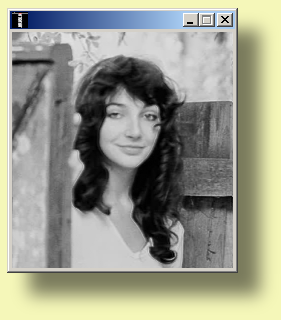
katebush.com
Please report your decode to
themightykbc@gmail.com
https://www.billboard.com/wp-content/uploads/2022/06/kate-bush-1978-billboard-1548.jpg

RSID: <<2022-07-28T02:48Z
MFSK-64 @
5850000+1500>>
This Is A Music Show #176
28 July 2022
0200-0300UTC Thursday on 5850 kHz
via WRMI, Okeechobee USA
***ALSO***
TIAnExpressMS w/ Radio Northern Europe International
via Channel 292 in Germany, mainly on 6070 kHz.
Broadcast various dates/times/freqs. Check the schedule here:
https://www.channel292.de/
https://rnei.org/
----------------------------------------
PLAYLIST
Frances - Batman
-----
The Who - Leaving Here
King FLyod - You've Been Good To Me, Thank You
Micheal Nesmith And The First National Band - Lady Of The Valley
-----
Wishbone Ash - Lady Wiskey
Al Kooper, Mike Bloomfield, Steven Stills - His Holy Modal Majesty
-----
Gregory Issacs - Stranger In Town
Shadow - Everybody Is Somebody
-----
Palm - Feathers
-----
THIS DATA w/ Bert Kaempfert - This Guy's In Love With You
-----
Mike "Malihini" Scott And The Hawaiianaires - Strange Enchantment
----------------------------------------
TIAMS Website:
https://thisisamusicshow.com
Go here for show archives + official shop!
-----
Please send reception reports/comments:
thisisamusicshow@gmail.com
Follow TIAMS on Twitter:
www.twitter.com/ThisIsAMusicSho/
------
Thanks for listening!
--YOUR HOST--
EOM
RSID: <<2022-07-28T02:50Z
MFSK-64 @
5850000+1500>>
Sending Pic:300x300Cp4;
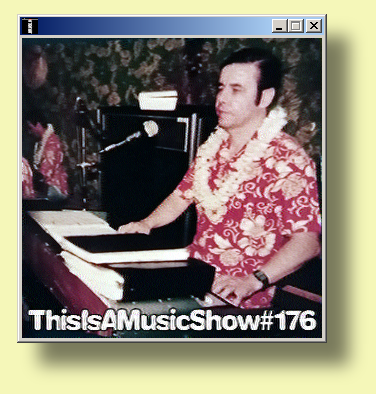
https://en.wikipedia.org/wiki/Lei_(garland)
https://hsga.org/in-memoriam/ ===> Michael Alan Scott [Mike "Malihini" Scott]